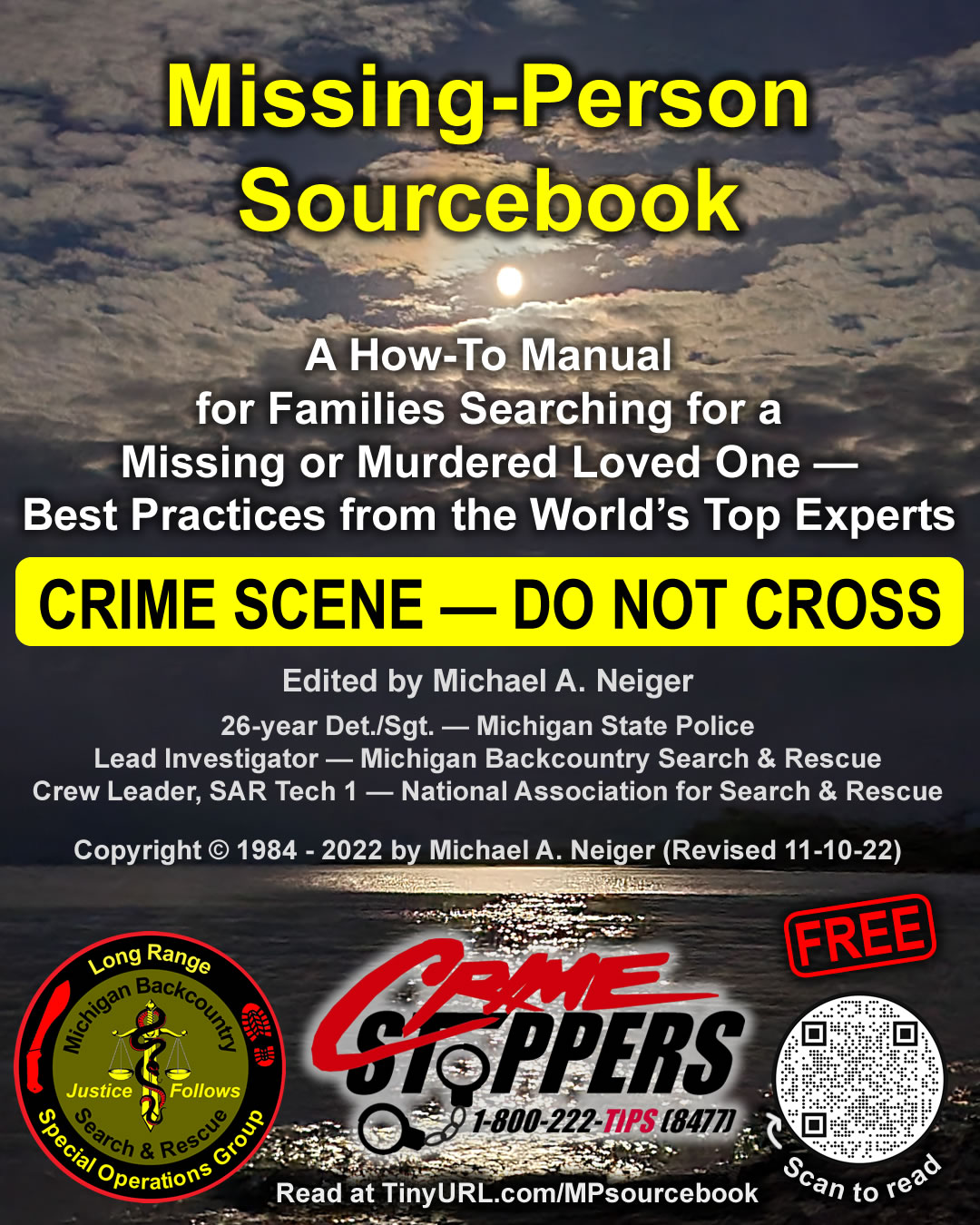
You're here: MibSAR :: M-P Sourcebook Table of Contents :: DNA
Understanding DNA & Forensic Evidence
| << Prior Chapter | Next Chapter >> |
Forensic evidence, particularly DNA, is a complex, ever-evolving subject.
If you're not sure about what can be done on your case from a evidentiary standpoint, use these resources — written by some of North America's top subject-matter experts — to double-check what you've been told is possible, and not possible.
Page contents:
- Identifying Victims Using DNA: A Guide for Families, by the National Institute of Justice (NIJ) and the National Human Genome Research Institute (NHGRI), U.S. Department of Justice, NCJ 209493, 2005, 13 pages.
- A Family’s Guide to the National Missing Persons DNA Program, by the Royal Canadian Mounted Police (RCMP), Canada, 2018, 6 pages.
- Handbook of Forensic Services, by the Laboratory Division, Federal Bureau of Investigation (FBI), 2019, 104 pages.
- Evidence Handbook, by Wisconsin Department of Justice, Division of Forensic Sciences, 11th edition, 2024, 258 pages.
- Handbook of Forensic Evidence for the Investigator, by the Centre of Forensic Sciences, Public Safety Division, Ministry of Community Safety and Correctional Service, Ontario, Canada, 2022, 41 pages.
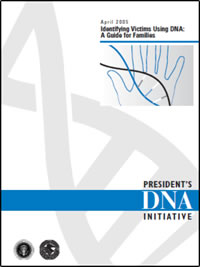 |
|
| Identifying Victims Using DNA: A Guide for Families, by the National Institute of Justice (NIJ) and The National Human Genome Research Institute (NHGRI) |
Contents:
- Why go through the process of identifying remains?
- How is testing done?
- How long will the process take?
- How can I help identify my loved one?
- What are the sources of DNA samples that can be used?
- What are the sources of DNA from the victim?
- How can DNA from relatives be used?
- Why might DNA analysis not work?
- How does DNA testing work?
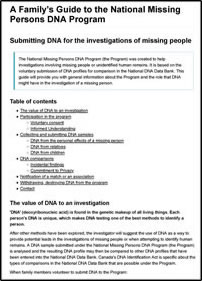 |
|
| A Family’s Guide to the National Missing Persons DNA Program, by the Royal Canadian Mounted Police (RCMP) | |
Contents:
- The value of DNA to an investi-gation
- Partici-pation in the program
- Voluntary consent
- Informed Understanding
- Collecting and submitting DNA samples
- DNA from the personal effects of a missing person
- DNA from relatives
- DNA from children
- DNA comparisons
- Incidental findings
- Commitment to Privacy
- Notification of a match or an association
- Withdrawing, destroying DNA from the program
- Contact
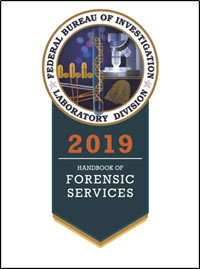 |
|
| Handbook of Forensic Services, by the Laboratory Division, Federal Bureau of Investigation (FBI) | |
This handbook provides guidance and procedures for safe and efficient methods of collecting, preserving, packaging, and shipping evidence.
It also describes the forensic examinations performed by the FBI’s Laboratory Division.
Contents:
- Table of Contents
- Introduction
- FBI Forensic Services
- Additional Case Acceptance Guidelines
- Submitting Evidence
- Requesting Evidence Examinations
- Packaging and Shipping Evidence
- Evidence Examinations And Services
- Forensic Facial Imaging
- Gambling Device Examinations
- Gambling Records Examinations
- GIS Mapping And Aerial Photograph
- Glass Examinations
- Graphic Arts (Commercial And Office Printing) Examinations
- Hair Examinations
- Handwriting And Hand Printing Examinations
- Human Smuggling Records Examinations
- Ink Examinations
- Known Handwriting Instructions
- Laboratory Shooting Reconstruction Team
- Latent Print (Friction Ridge) Examinations
- Liquid Soaked Document Preservation
- Loan Records Examinations
- Lubricant Examinations
- Metallurgy Examinations
- Muzzle-To-Target Distance Determination
- National DNA Index System/Combined DNA Index System
- National Integrated Ballistic Information Network (NIBIN)
- National Missing Person DNA Database (NMPDD) Program
- Packaging Examinations
- Paint Examinations
- Paper Examinations
- Paper Reconstruction
- Pepper Spray Examinations
- Pharmaceutical Examinations
- Photocopy Or Facsimile Examinations
- Photo Processing
- Plastic Bag Examinations
- Polymer Examinations
- Post-Mortem Forensic Facial Imaging
- Product Tampering Examinations
- Prostitution Records Examinations
- Radioactive Materials Examinations
- Rope or Cordage Examinations
- Rubber Stamp Examinations
- Safe Insulation Examinations
- Serial Number (Altered) Examinations
- Soil Examinations
- Special Event And Situational Awareness Support
- Symbol Examinations
- Tape Examinations
- Threatening Communication Database
- Toolmark Examinations
- Toxicology Examinations
- Typewriting Examinations
- Unknowns (General Chemical) Examinations
- Weapons Of Mass Destruction/CBRN Examinations
- Crime Scene Safety
- Routes of Exposure
- Safety
- Personal Protective Equipment
- Hazardous Materials Transportation
- Hazardous Waste Regulations
- References
- Index
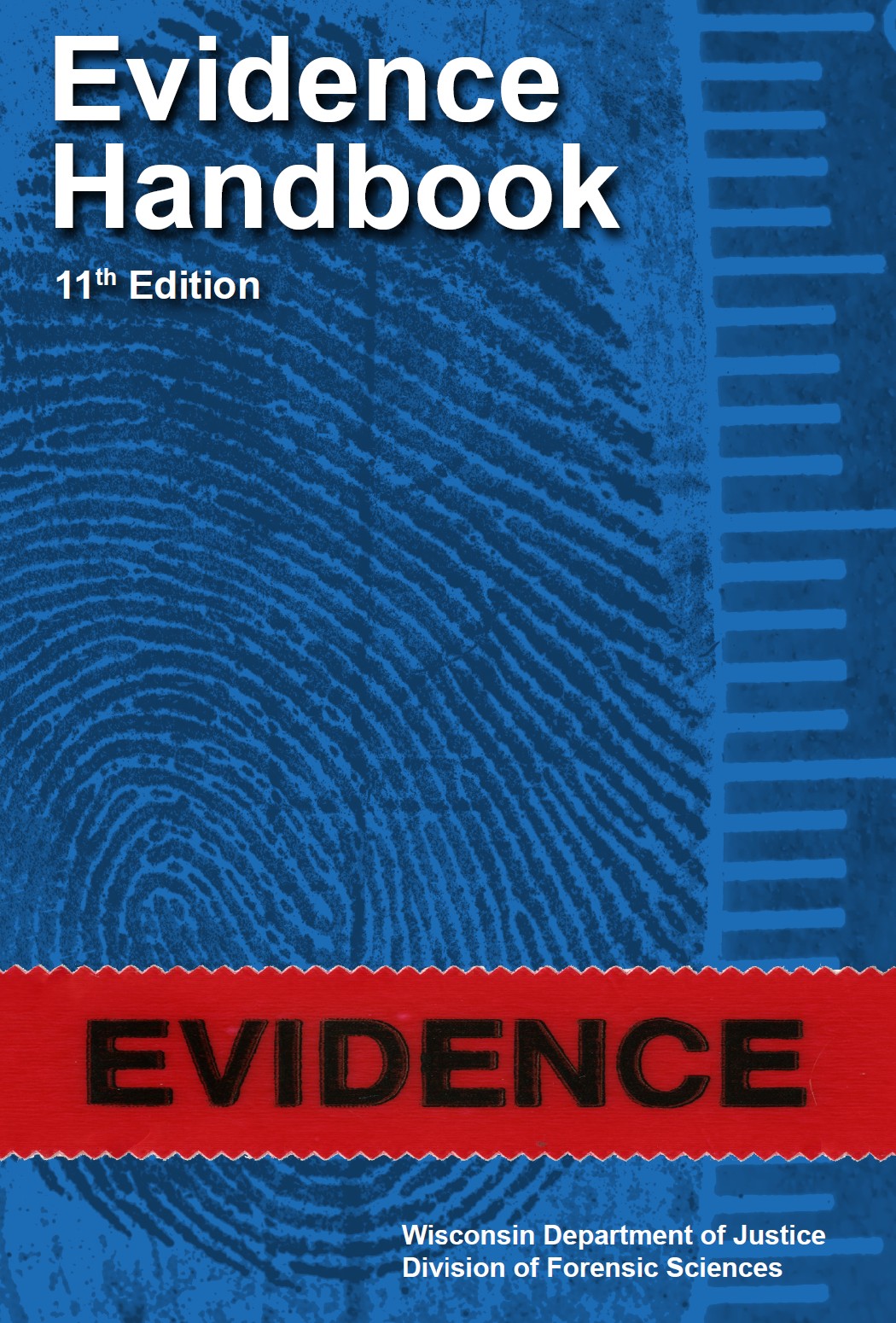 |
|
| Evidence Handbook, by the Wisconsin Department of Justice, Division of Forensic Sciences | |
This handbook is offered in the belief that increased knowledge leads to understanding and that understanding leads to excellence.
It describes the types of evidence the Wisconsin Crime Laboratories forensically analyze.
Contents:
- Introduction
- Evidence Integrity
- Forensic Photography
- Video and Audio Recordings
- Crime Scene Sketch
- Bloodstain and Pattern Analysis
- DNA Evidence and Standards
- Sexual Offenses
- DNA Databank
- Questioned Documents
- Firearms and Ammunitions
- Footwear and Tire Examinations
- Footwear and Tire Impressions
- Latent Prints
- Major Case Prints
- Automated Fingerprint Identification
System (AFIS)
- Burglary
- Building Materials
- Glass
- Tool Marks
- Paints
- Metals
- Clothing and Fabrics
- Hairs and Fibers
- Woods and Sawdust
- Fracture and Tear Matches
- Vehicles
- Autopsy
- Identification of Unknown Deceased
- Dental Identification of Human Remains
- Toxicology
- Poisoning
- Controlled Substances
- Arson
- Explosives, Bombs and Fireworks
- Appendix - Bloodborne Pathogens
- Appendix - Collection Kits
- Appendix - Evidence Submission Guidelines
- Index
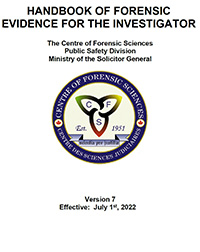 |
|
| Handbook of Forensic Evidence for the Investigator, by the Centre of Forensic Sciences | |
This handbook provides an overview of the collection and packaging requirements for items being submitted to Centre of Forensic Sciences laboratories.
Contents:
- General Information
- Documentation
- Collection and packaging of evidence items
- Druggist’s fold for collecting trace samples
- Adhesive tape
- Comparison samples
- Comparison samples
- Ammunition
- Unfired
- Fired Comparison samples
- Rapid assessment for IBIS selection examination (RAISE) cases
- Biology DNA High Volume Service
- Blood alcohol kits (BAKs)
- Bloodstains
- Wet/dry stains on a non-absorbant surface
- Wet/dry stains on an absorbant surface Comparison samples
- Body tissues/post-mortem samples (other than lung)
- Comparison samples
- Comparison samples
- Bones/teeth
- Comparison samples
- Comparison samples
- Building materials (plaster, concrete, insulation)
- Questioned samples
- Comparison samples
- Chemical, biological, radiological and nuclear (CBRN) materials
- Chewing gum
- Comparison samples
- Comparison samples
- Cigarette butts
- Comparison samples
- Comparison samples
- Clothing – for analysis of blood, saliva, semen and DNA analysis
- Comparison samples
- Comparison samples
- Clothing – for damage analysis
- Comparison samples
- Comparison samples
- Clothing – for gunshot residue analysis, see “GSR – on clothing”
- Clothing – for trace analysis (e.g. glass, paint, hairs and fibres)
- Clothing – for analysis of volatile ignitable liquids
- Comparison samples
- Comparison samples
- Condoms
- Comparison samples
- Comparison samples
- Controlled substances
- Comparison samples
- Comparison samples
- Cosmetics
- Comparison samples
- Comparison samples
- Counterfeit bank notes
- DNA High Volume Service
- DNA samples – for comparison purposes
- Blood samples collected by finger-prick
- Pulled hairs
- Oral/buccal swab
- Atypical samples
- Reference/personal effect samples
- Discard samples
- DNA samples – for comparison purposes
- DNA samples – obtained by warrant
- DNA samples – obtained by consent
- Dye-pack dye (MAAQ)
- Drug and alcohol analysis
- Envelope flaps and stamps
- Comparison samples
- Comparison samples
- Explosives
- Fibres
- Comparison samples
- Comparison samples
- Fingernail clippings and scrapings
- Clippings
- Scrappings
- Comparison samples
- Fingerprinting
- Fire debris
- Comparison samples
- Comparison samples
- Firearm discharge residue – distance determination
- On clothing
- On tissue
- Comparison samples
- Firearms
- Forensic cases
- Comparison samples
- Suspicious Firearms Index (SFI) cases
- Food
- Food for DNA analysis
- Comparison samples
- Gases
- Comparison samples
- Comparison samples
- Glass
- On clothing and footwear
- Loose particles
- Comparison samples
- Other glass examinations
- Gunshot residue (GSR)
- GSR - on hands
- GSR - on vehicles
- GSR - on clothing
- Comparison samples
- Hairs
- Comparison samples
- Comparison samples
- Handler DNA
- Comparison samples
- Comparison samples
- Handwriting, handprinting and signatures
- Comparison samples
- Comparison samples
- High Volume Service
- Indented writings
- Ink comparisons
- Lachrymators (Mace, pepper spray, tear gas)
- Letter of opinion (Toxicology Section)
- Lungs
- Comparison samples
- Comparison samples
- Maggots
- Metals
- Comparison samples
- Comparison samples
- Noxious substances (acids, bases, bleach, etc.)
- Questioned samples
- Comparison samples
- Clothing
- Paint
- Questioned and comparison samples
- Questioned and comparison samples
- Printing machines (cheque protectors/writers, computer printers, fax machines, photocopiers, typewriters)
- Penile swabs
- Saliva
- Comparison samples
- Comparison samples
- Semen
- Comparison samples
- Comparison samples
- Serial numbers
- Sexual assault evidence kit (SAEK)
- Comparison samples
- Comparison samples
- Sexual lubricants
- Comparison samples
- Comparison samples
- Suspicious liquids or powders
- Syringes
- Comparison samples
- Comparison samples
- Toolmarks
- Comparison samples
- Comparison samples
- Tools
- Vehicles
- Weapons (knives, scissors, etc.)
- Comparison samples
| << Prior Chapter | Next Chapter >> |
People who say it cannot be done,
should not interrupt those who are doing it.
— Author unknown
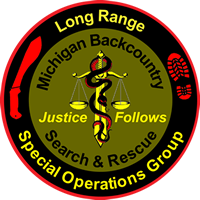
If you've been able to read this
Web page...
thank a Teacher;
If you've been able to read this
Web page in English...
thank a Veteran.
— Author unknown
Copyright © 1984-
March 22, 2025
by Michael A. Neiger
Contact Michael Neiger via e-mail at mneiger@hotmail.com
Top
You're here: MibSAR :: M-P Sourcebook Table of Contents :: DNA